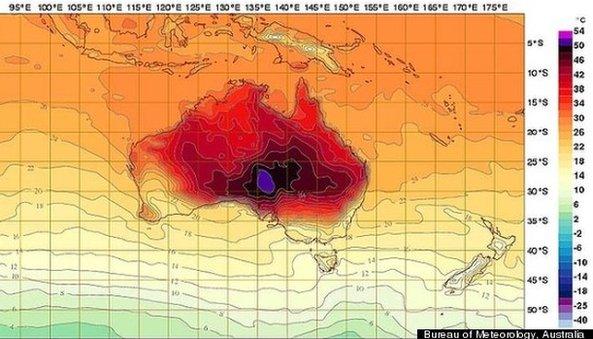Australian wildfires add to growing confusion over climate
- Published
- comments

Australian meteorologists have added dark purple and magenta to their colour coded weather maps - to represent temperatures from 51 to 54C
I don't know about you, but the recent row about Met Office climate predictions and a slowdown in global warming has left me shrugging my shoulders.
Yes, obviously the science is important and the issue is critical to our survival as species etc etc, but arguments about experimental models and degrees of difference seem really far removed from the concerns and interests of many people.
Except perhaps in Australia right now, where temperatures are quite literally heading off the chart.
The ongoing heat wave that has sparked highly destructive wildfires, has forced weather forecasters to add new colours to their weather maps to indicate when the mercury rises above 50C.
It's something that might happen early next week.
To date, four of Australia's hottest days on record have been in 2013.
So hot has it been, that the owners of one petrol station had to stop selling fuel as it was vaporising before their eyes.
According to researchers, one of the immediate causes of the problems down under is, ironically, rain.
Perfect fire storm
An extended La Nina, external season appears to have given southern and south eastern Australia a real watering over the past two years. Trees and plants have grown rapidly and extensively. But when temperatures rise, these quickly become fuel for the fires.
Unfortunately, the second half of 2012 was extremely dry, with the daily temperature 0.11 degrees above the daily average. This has created the perfect conditions for raging fires.
In these circumstances, when human intervention seems as ineffective, politicians are often quick to point the finger at a vague notion of global warming.
"Whilst you would not put any one event down to climate change," said Australian Prime Minister Julia Gillard, "We do know over time that as a result of climate change we are going to see more extreme weather events and conditions."
Scientists, though, have been remarkably silent on the connection.
It makes an interesting contrast with the last time major fires threatened Australian homes and lives in 2009, when researchers and others were ready to make a more direct link , externalwith climate change.
This time, some Australian politicians have been scornful, external, suggesting that more carbon would be released by the current fires consuming trees than there will be from coal-fired power stations for decades to come.
The connection between climate change and wildfires has become a bit more certain. In a paper, external published last year, leading Australian experts predicted an increased risk of fire in some of the areas now suffering the worst affects, including Tasmania and South Australia.
But the report couldn't clearly identify the source of that change.
"Although these trends are consistent with projected impacts of climate change, " it said, "this study cannot separate the influence of climate change, if any, with that of natural variability."
Meanwhile, despite the supposition in the UK that global warming may actually be stuck on pause over the past two decades, new figures, external from the US suggest that 2012 was the warmest year ever recorded. And scientists say that some of that rise is undoubtedly being driven by human activities.
According to Prof Roger Pielke Jnr, from the University of Colorado, there are big dangers in claiming that one event, be it US weather records or wildfires in Australia, are clear evidence of human-induced climate change.
"Such claims simply invite the reaction we see from the sceptical side about the slowdown in global temperatures over an extended period," he told me.
"The climate system is complex enough to provide cherries for picking by either side."
Follow Matt on twitter, external.